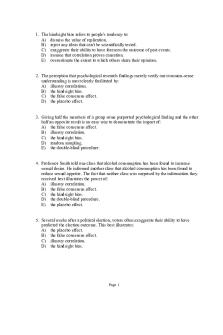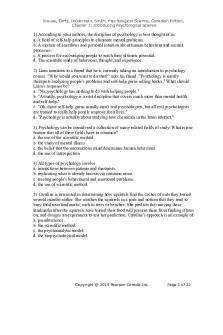Test 1 Essay Questions PDF

| Title | Test 1 Essay Questions |
|---|---|
| Course | History of Rock Music |
| Institution | Vanderbilt University |
| Pages | 5 |
| File Size | 121.1 KB |
| File Type | |
| Total Downloads | 89 |
| Total Views | 148 |
Summary
test.1 essay questions...
Description
TEST 1 POTENTIAL ESSAY QUESTIONS:
Important Dates · 1958/1959 – the day music died · 1965 – Newport Folk Festival · 1960 – Payola got really big; Kennedy was elected; shift between two periods of rock we focused on 1. Describe the shift in musical style which happened between the mid/late-50s and early 1960s. What were the forces that created this shift, in terms of both specific artists and the surrounding culture? ● 1) Intro ○ 1954-1959, Rock influenced by R&B dominated the music scene ○ Little Richard, Chuck Berry, Elvis, and Buddy Holly - wild stage presence ○ New tech allowed them to become wildly popular in a short time ○ These original Rock ‘n’ Rollers delivered something totally new ● The shift (by 1959)-- music became more subdued ○ Elvis was drafted ○ Little Richard left rock to become a preacher ■ He was a flamboyant performer ■ The “Architect of Rock & Roll ■ Songs with raunchy lyrics ○ Chuck Berry was having legal troubles due to relationship with underage white girl ■ Duck walk- he was a showman ○ Jerry Lee Lewis married his underage cousin ■ Intensely played the piano ○ February 3, 1959 - “The Day the Music Died” ■ Received the name from Don McLean’s 1971 song “American Pie” ■ Big Bopper, Buddy Holly, and Ritchie Valens died in a plane crash ● “hiccup “ style singing and influential rhythmic guitar style ○ Eddie Cochran and Gene Vincent were in a car crash (1960) ■ Cochran died, Vincent’s career effectively ended ○ Backlash against rock music ■ Payola scandal in 1960 (election year) ■ Direct and indirect backlash against rock music by parents’ groups, racist groups, the mainstream music industry, and the government ● Direct: banning records, lawsuits against musicians & DJs, etc. ● Indirect: mainstream music industry co-opted the music of independent labels & black artists
●
Racially driven- did not want sexual music made by African Americans on the radio ● Post-shift rock - teenie boppers ○ Rise of teen idols like Paul Anka and the Penguins ■ More polished, sedate, pop-oriented ○ Emphasis on vocals instead of band sound ○ Fueled by Dick Clark’s show, “American Bandstand” ■ Fueled teen idol and dance crazes ■ Teenage girls particularly responded ■ Rock became more respectable, less controversial ○ New professionalism set the stage for later rock developments ■ Segwayed into surf rock (think Beach Boys, “Good Vibrations”) ● Post-shift rock - folk music ○ The music revolved around social conflict of the early 60s ■ Vietnam war, civil rights movements, JFK assassination ■ Expanded to women’s rights and gay rights ■ Environmentalist movement ■ Sexual revolution ■ Bob Dylan incorporated political activism (protest songs) ■ Songs were no longer superficial with a polished voice ○ Songs began to be an integral part of social movements of the day ○ Focused on serious, earnest lyrics ■ Vocals are clean and lyrics well understood, downplay of rhythm 2. What significant even in rock history happened at the 1965 Newport Folk Festival? Why was this event important, and how did rock music, and folk music, change in the aftermath? ● Bob Dylan went electric at a time when folk music was seen as the artist thing and he showed rock could be an artistic music ● Fused genres ● Mr. Tambourine Man came out before he even went electric ● Dylan was mainstream person for this, but there were other artists 3. Who are the members of the “Million Dollar Quartet”, and what was their contribution to rock history? What was the name of the record label they were all signed to, and who ran that label? ● Elvis Presley, Johnny Cash, Jerry Lee Lewis, Carl Perkins ● All under same roof at the same time
Sun Records Sam Phillips ● This would make a very short essay ● ●
4. Describe musical characteristics of the three musical traditions which were the primary roots of rock and roll, and name at least one artist from each pre-rock genre. Of the three traditions, which one played the most dominant role in the creation of rock?
R&B: Muddy Waters Country: Hank Williams ● Tin Pan Alley (Pop): Frank Sinatra ● Chuck Berry – R&B and country influence ● These helped start movement, innovate it and carry it ● ●
5. Describe how specific changes in technology, media, the economy, and demographics in the mid-1950s combined with Elvis Presley’s talent and charisma to create his overwhelming dominance during this period of rock history.
● 1) Intro ○ Booming economy, tech changes, and young population allowed rock n roll to blossom ○ Combined w/ Elvis’s qualities, he quickly became a living legend and pop icon ○ Sam Phillips discovered him as a white boy who had the looks, talent, and charisma to record black songs and sell them to a white audience ○ Elvis’ Impact ■ The most important figure in rock music history ● Popularized rock & roll on an international level, brought rock into mainstream culture, and paved the way for musicians that followed ● Unprecedented commercial success- over 1 billion records sold- continues decades after his death ● 2) Technology ○ Television ■ Freed up airwave space for new R&B / rock programming ■ Ed sullivan show was watched by 1 in 3 Americans, and Elvis was a frequent guest ■ Elvis had a commanding, sensual stage presence, so TV made him even more enthralling than the radio (especially for teenage girls) ● Elvis was uniquely suited for TV ○ Radio ■ Portable transistor radios, car radios, radios & jukeboxes meant teenagers could listen to their own music in their rooms ■ Top 40 radio programming meant Elvis had a lot of air time ● Fewer artists being played meant they were getting higher numbers of spins
○ Film ■ Development of teen-oriented movies ● (1) Teen oriented movies- ex: Blackboard Jungle featured Bill Haley’s “Rock around the Clock” ■ Elvis starred in some movies thanks to his manager, Tom Parker ● Parker was a marketing genius, made Elvis more popular than Elvis could have been on his own ● 3) Economy ○ Booming economy -> teenagers have money to buy cars ■ Could listen to rock n roll in their cars (away from their disapproving parents) ● 4) Demographics ○ Baby boomers were teenagers ■ Large number of teenagers in the 50s, and they were the primary audience for rock n roll 6. What is payola? How and why did it become illegal? ● Pay-for-play ● Example of first essay question and why music changed – payola became
illegal 7. What is meant by the term “vanilla version”? Describe the complicated legacy that vanilla artists like Pat Boone have in rock music history, using specific examples in your essay. ● White artists would take black songs and make them “whiter,” more
clean-cut, less swing ● Someone stealing art, but also helped make some black artists bigger stars ○ Little Richard and Tutti Frutti ● Elvis and Carl Perkins – vanilla versions but some artists were more authentic than others 8. Describe the roots of the mid-1960s folk music revival (pre-Bob Dylan). ● Roots of folk music stretch very far back – Appalachian folk music; Irish
and Scottish immigrants getting off boats ● 1940s – almanac singers: Pete Weaver and Woody Guthrie (most important for this era) ○ Folk artists using voices in simple way to get across powerful political messages ○ A lot of them had careers ended by McCarthy-ism for being too socialist
9. The early 1960s, while dominated by teen pop, also saw some important creative innovations in rock music which laid the groundwork for the next great wave of musicians. Explain, detailing the contributions of specific artists in your essay. ● Phil Spector, Brian Wilson, Paul Anka ● Talk about 1960s and what happened/who innovated
Tail-end of the pendulum; pointing towards what’s going to happen in late 1960s/early 1970s ● Beach Boys – spending so much money, Phil Spector wall of sound, most artistic music happening at the time ● R&B → teen idols → girl groups (transition to back to rock except for Ronnettes – Phil Spector was working with them – very commercialized role, but doing stuff very innovative for the time)
●
10. Describe the various strategies Motown Records employed to create, package, and sell great R&B and pop music to the American mainstream in the mid-1960s, naming specific people (artists and label employees) in your essay. ● Berry Gordy – black-owned record label with black artists
Pulling songwriters to write material then having artists perform material Know artists signed here ○ Supremes, Stevie Wonder, etc. ● Know about Motown in general (really important)
● ●...
Similar Free PDFs

Test 1 Essay Questions
- 5 Pages

Test 1 sample questions
- 6 Pages

Macbeth Test 1 Questions
- 1 Pages

Chapter 1 Test Questions
- 34 Pages

Test 1 2019, questions
- 22 Pages

Term Test 1 Questions
- 8 Pages

Sat practice test 1 essay
- 4 Pages

Test 1 May 2016, questions
- 9 Pages

Test 1 December 2016, questions
- 11 Pages

Mod 1 & 2 - Test Questions
- 10 Pages

HA1 Test 1 study questions
- 20 Pages

Chapter 1 Test bank questions
- 72 Pages

Long-answer Questions Test 1
- 1 Pages
Popular Institutions
- Tinajero National High School - Annex
- Politeknik Caltex Riau
- Yokohama City University
- SGT University
- University of Al-Qadisiyah
- Divine Word College of Vigan
- Techniek College Rotterdam
- Universidade de Santiago
- Universiti Teknologi MARA Cawangan Johor Kampus Pasir Gudang
- Poltekkes Kemenkes Yogyakarta
- Baguio City National High School
- Colegio san marcos
- preparatoria uno
- Centro de Bachillerato Tecnológico Industrial y de Servicios No. 107
- Dalian Maritime University
- Quang Trung Secondary School
- Colegio Tecnológico en Informática
- Corporación Regional de Educación Superior
- Grupo CEDVA
- Dar Al Uloom University
- Centro de Estudios Preuniversitarios de la Universidad Nacional de Ingeniería
- 上智大学
- Aakash International School, Nuna Majara
- San Felipe Neri Catholic School
- Kang Chiao International School - New Taipei City
- Misamis Occidental National High School
- Institución Educativa Escuela Normal Juan Ladrilleros
- Kolehiyo ng Pantukan
- Batanes State College
- Instituto Continental
- Sekolah Menengah Kejuruan Kesehatan Kaltara (Tarakan)
- Colegio de La Inmaculada Concepcion - Cebu


